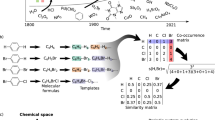Maybe we can even be at the point of a revolution in representation of the periodic system, which is being marked by current developments.
—Eric R. Scerri (2004)
Abstract
This article discusses the mathematizing of the chemical periodic system as a grid, which leads to a quadratic function or “binódica function” formed by pairs of periods or binodos (dyads). We describe the periodic law as an increasing function of the principal quantum number (n). It works subject to the dialectical laws that generate; first: gradual quantitative changes: (2n2), with “duplication” of periods: (2n2, 2n2). Second: radical quantitative changes: (4n2), with the emergence of new quantum transitions, growth and a change in the format of the binodos (qualitative change). We use analytical and graphic methods to mathematize Mendeleev’s law, making the size of the binodos (Y) and the continuous series (Z) depend on the number of the binode (B), which is the same quantum number (n). Likewise, we show a graphic representation, in 2D, of a continuous and self-similar spiral function of the elements, in a geometric growth pattern.





















Similar content being viewed by others
Notes
Rule of Madelung-Klechkowski, also of Pao Fang Yi, R. Hakala, rule (n + l), rule of the handsaw, etc. It is an empirical rule for electron filling in atomic orbitals. It is not exact, there are 19 exceptions. E. Scerri, and especially Eugene Schwarz, have clarified the critical points at which this rule, which is not derived from quantum mechanics, is inconsistent with empirical results. Schwarz believes that the Madelung Rule is incorrect and that “it has never been and cannot be proven by quantum theory”; personal correspondence, June 13, 2012. (Ostrovsky denies this way of thinking).
This concept of spirals rolled in a cone was developed from an idea of Baca Mendoza (1953), where he comments on the development of concatenated stages that form enveloping spirals like spindles, on a cone.
That is, in “a final equation whose contemplation produces the same effect as the culmination of a work of art.” In this symmetrical way, something is hidden in the parabolic equation or in the spirals: "The beauty that inspires a melody, a painting or a poetry” (Álvarez Vita, Beauty as a Guide for Science, undated monograph).
Mandelbrot (1982) formulates a geometry of fractals which has characteristics of self-similarity. An object is self-similar if parts have the same shape as the whole structure, but may be in a different scale and slightly deformed. The fractal dimension is generated by mathematical algorithms or iterated function systems.
In 1862, Chancourtois (1830–1889) devised a telluric helix rolled in a cylinder in which he distinguished the periodicity of the second binode with (8, 8) elements. His proposal was not fulfilled for the following periods or dyads—(18, 18), (32, 32)—because the sequence of elements was incomplete.
Libedinsky (1938) postulates a singular spiral classification or "dialectical grouping of the elements" that we find published in: https://www.meta-synthesis.com/webbook/35_pt/pt_database.php?PT_id=909.
The spectral distribution exhibits numerous exceptions noted by many authors; however, in the proton sequence there can be no such exceptions because the identity of the element or the atomic number completely identifies it.
“Clearly, there is a general desire for a sleeker periodic system that fits well with modern physical theories of matter. Maybe we can even be at the point of a revolution in representation of the periodic system, which is being marked by current developments. In addition, the new field of philosophy of chemistry has led to renewed interest in the fundamental aspects of the central model of chemistry, the periodic table. Perhaps the time is ripe for a new careful assessment of the best possible representation”; Scerri (2004). “The best representation for the periodic system: the role of the rule n + l and the concept of an element as basic substance”, in: D.H. Rouvray and R.B. King (eds.), The Periodic Table in the XXI century. Research Studies Press, Chapter 5, 2004.
References
Álvarez Vita, E.: La Belleza como guía de la Ciencia. (Monograph, undated). https://www.monografias.com/trabajos55/belleza-guia-de-la-ciencia/belleza-guia-de-la-ciencia.shtml. Accessed 17 Mar 2018
Baca Mendoza, O.: Leyes Genéticas de los elementos Químicos, Nuevo Sistema Periódico. [Genetic laws of the chemical elements, a new periodic system]. National University of Cusco. https://www.meta-synthesis.com/webbook/35_pt/pt_database.php?PT_id=407 (1953). Accessed 5 Apr 2018
Baca Mendoza, O.: Ley de Configuraciones Electrónicas. National University of Cuzco, Cusco (1965)
Bachelard, G.: Materialismo Racional. Editorial Paidos, Argentina (1976)
Badiou, A.: Elogio de las matemáticas. Editorial Capital Intelectual, Argentina, p. 22 (2016)
Bair, S., McIntyre, L.: Philosophy of Chemistry: Synthesis of a Discipline. Fondo de Cultura EconómicaMéxico (2011)
Bent, H.: New Ideas in Chemistry from Fresh Energy for the Periodic Law. AuthorHouse, Bloomington (2006)
Bunge, M.: La Ciencia, su método y filosofía. Editorial Siglo XX, Buenos Aires, p. 7 (1960)
Ceulemans, A., Thyssen, P.: The “chemical mechanics” of the periodic table. In: Scerri, E., Restrepo, G. (eds.) Mendeleev to Oganesson: A Multidisciplinary Perspective on the Periodic Table. Oxford University Press, Oxford (2018)
Emerson, B.K.: Helix chemica. A study of the periodic relations of the elements and their graphic representation. Am. Chem, J. 45, 160–210 (1911)
Engels, F.: Second Anti-Dühring prologue (1877–1878)
Engels, F.: Dialectics of Nature, Edit. Grijalvo, Mexico, p. 46 (1962)
Gutiérrez Samanez, J.A.: Sistema Periódico Armónico y Leyes Genéticas de los Elementos Químicos. Cusco Perú, ISBN: 9972-33-063-X. https://www.meta-synthesis.com/webbook/35_pt/pt_database.php?PT_id=1100 (2004)
Gutiérrez Samanez, J.A.: Binódica periodic table, as a mathematical function. In: Document for the Third International Conference on the Periodic Table. Global University of Cusco, Cusco (2012)
Hakala, R.W.: J. Chem. Educ. Lett. Chem. Educ. 29(11), 581 (Letter). https://doi.org/10.1021/ed029p581.2. https://pubs.acs.org/doi/pdf/10.1021/ed029p581.2 (1952). Accessed 13 Dec 2019
Hegel, G.W.F.: https://historia-biografia.com/georg-wilhelm-friedrich-hegel/ (1770). Accessed 5 Jan 2019
Imyanitov, N.S.: Dialectic and synergetic in chemistry. Periodic Table and oscillating reactions. Springer, Dordrecht (2015)
Imyanitov, N.S.: The periodic law. Formulations, equations, graphics. Russ. J. Inorg. Chem. 56(14), 2183–2200 (2011)
Janet, C.: Helical classification of elements. Chem. News 138, 372–374, 388–393. (1929[1928])
Katz, G.: The periodic table: a table of eight terms for the XXI century. Chem Educator 6, 324–332 (2011). https://doi.org/10.1007/s00897010515a
Kuhn, T.: The Structure of Scientific Revolutions. Fondo de Cultura Economica, Mexico (1971)
Libedinsky, S.: El Materialismo Dialéctico. Editions Ercilla, Santiago de Chile. https://www.meta-synthesis.com/webbook/35_pt/pt_database.php?PT_id=909 (1938)
Longman, E.: https://meta-synthesis.com/webbook/35_pt/pt_database.php?PT_id=24 (1951). Accessed 18 Apr 2018
Mandelbrot, B.: Fractal Geometry of Nature. https://es.slideshare.net/fernandoruffino/mandelbrot-benot-la-geometra-fractal-de-la-naturaleza (1982). Accessed 19 Feb 2020
Mazurs, E.: Graphic Representations of the Periodic System for a Hundred Years. University of Alabama, Tuscaloosa (1974). ISBN 0-8173-3200-6
Osorio, R.D., Alzate, M.V.: La Tabla Periódica, 100 años después de la muerte de Mendeleiev. Colombia, p. 224, Fig. 122 (2012)
Ostrovsky, R.C.V.: What and how physics helps to understand the periodic law. Found. Chem. 3, 145–182 (2001)
Petrianov, I.V., Trifonov, D.N.: La Magna Ley, p. 152. Mir Publishers, Moscow (1981)
Rydberg, J.: http://www-groups.dcs.st-and.ac.uk/history/Biographies/Rydberg.html (1912). Accessed 30 July 2018
Samaja, J.: Epistemología y Metodología. Elementos para una teoría de la investigación científica. Eudeba (1999)
Scerri, E.R.: Chapter 5: The best representation for the periodic system: the role of the rule n + l and the concept of an element as basic substance. In: Rouvray, D.H., King, R.B. (eds.) The Periodic Table in the XXI Century. Research Studies Press, Baldock (2004)
Scerri, E.R.: The Periodic Table: Its History and Its Significance. Oxford University Press, Oxford (2007)
Scerri, E.R.: Selected Papers on the Periodic Table. Imperial College Press, London (2009)
Stewart, P.J.: Charles Janet: unrecognized genius of the periodic system. Found. Chem. 12(1), 5–15 (2010)
Van Spronsen, J.W.: The Periodic System of Chemical Elements: A History of the First Hundred Years. Elsevier, Amsterdam (1969)
Yonidi, P.P.: Conception of the World of Mendeleev. Academy of Sciences of the USSR, Moscow (1959)
Acknowledgements
In memory D.I. Mendeleev in the 150th Anniversary of the publication of the Periodic Table. In memory of Dr. Oswaldo Baca Mendoza, whose work inspired the author of this study. With gratitude to Dr. Eric Scerri, for his example, support and encouragement that he gave me for this work. My thanks to Dr. Conal Boyce for providing constructive criticism during an early phase of the project, in 2018, and to Mark Leach, Milagros Paredes, Lucas Pierce Paredes, Ana María Enciso, Dimitri Weise, G. Restrepo, Alfio Zambón, Rolando Alfaro, M. Labarca, and the group “Periodic Table mailing list” (moderated by E. Scerri). In memory of Ray Hefferlin and Rubén Darío Osorio.
Author information
Authors and Affiliations
Corresponding author
Ethics declarations
Conflict of interest
The author declares that there no conflict of interest.
Additional information
Publisher's Note
Springer Nature remains neutral with regard to jurisdictional claims in published maps and institutional affiliations.
Appendices
Appendices
Appendix 1: New periodic system of the elements of Dr. O. Baca Mendoza (1953)

Appendix 2: ‘Left step’ periodic table of Charles Janet (1929[1928])

Rights and permissions
About this article
Cite this article
Gutiérrez Samanez, J.A. Binódic periodic system: a mathematical approach. Found Chem 22, 235–266 (2020). https://doi.org/10.1007/s10698-020-09359-3
Published:
Issue Date:
DOI: https://doi.org/10.1007/s10698-020-09359-3




